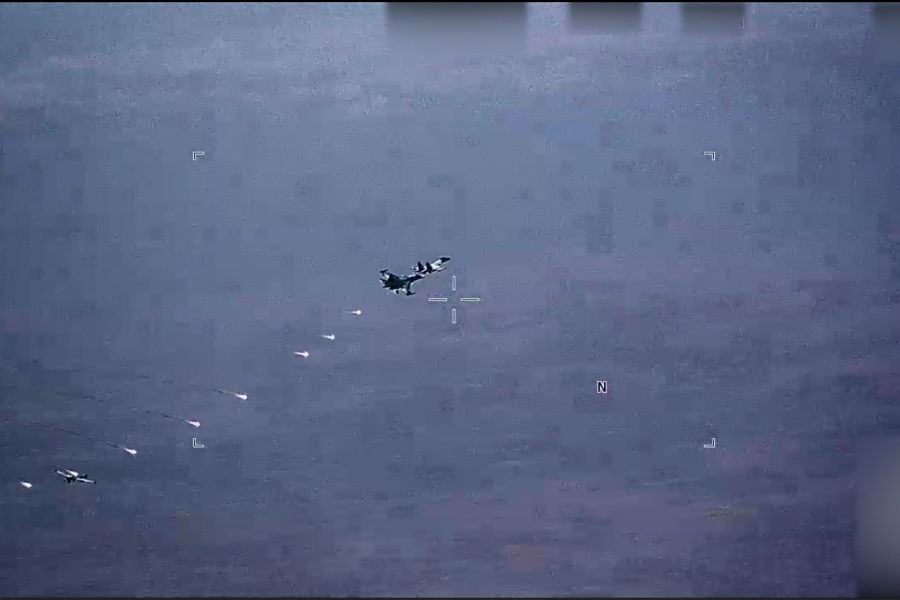After three straight days of harassment by Russian fighters, U.S. MQ-9s conducted an airstrike in Syria that killed an ISIS leader in Syria on July 7, U.S. Central Command and Air Forces Central said.
Usamah al-Muhajir, a leader of the militant group, was killed in the strike, CENTCOM said in a statement. No civilians were killed and the command said it is assessing whether any were injured.
The same three MQ-9s overcame harassment by Russian fighters earlier in the day, U.S. officials said. The Russians confronted and harassed the drones over a period of about two hours. It was the third straight day of similar encounters.
“Earlier today three MQ-9 drones were once again harassed by Russian fighter aircraft while flying over Syria,” Air Forces Central Commander Alexus G. Grynkewich said in a July 7 statement, before the strike was announced. “During the almost two-hour encounter, Russian aircraft flew 18 unprofessional close passes that caused the MQ-9s to react to avoid unsafe situations.”
According to U.S. officials, the encounter with the Russians was in western Syria. A U.S. official said the strike occurred in western Syria.
The July 7 incident was the latest in a series of Russian maneuvers intended to disrupt U.S. operations over Syria. On July 5, three U.S. MQ-9 Reaper drones on a mission against ISIS targets were intercepted by Russian fighters, which dropped parachute flares and engaged an afterburner in front of the U.S. drones. On July 6, Russian fighters released flares in front of two MQ-9s on an anti-ISIS mission.
In addition to the weaponry used July 7, Reapers also have intelligence, surveillance, and reconnaissance capabilities. The Pentagon swiftly declassified and released video of the first two incidents captured from the Reapers’ on-board cameras.
“We have made it clear that we remain committed to the defeat of ISIS throughout the region,” CENTCOM commander Army Gen. Michael “Erik” Kurilla added in a statement. “ISIS remains a threat, not only to the region but well beyond.”
Grynkewich and other U.S. military officials continue to raise alarm over Russian flying behavior over Syria, saying it endangers both sides’ forces and risks inhibiting U.S. operations against ISIS, which Russia ostensibly supports.
After a pause in Russian air activity near U.S. positions over the winter, Russian warplanes resumed regularly overflights of U.S. positions in Syria beginning in March. That same month, a U.S. base in northeast Syria was targeted in a strike by Iranian-backed militia in an incident that killed an American contractor.
The U.S. has around 900 troops in Syria to assist its Kurdish allies in fighting the remnants of ISIS. Russia is supporting the regime of Bashar Al-Assad. Grynkewich has said that Russian jets violate mutually agreed-upon deconfliction protocols designed to reduce the risk of inadvertent conflict in Syria and to keep the two nations’ air forces separate in eastern Syria. Since spring, Air Forces Central has said Russian jets have come as close as 500 feet from manned U.S. aircraft and considerably closer to uncrewed drones. Russians have also overflown U.S. troops dozens of times in violation of protocol.
The U.S. recently deployed F-22s to the region. A-10s and other U.S. aircraft have been used to patrol Arabian Gulf waters, after Tehran stepped up seizures of commercial vessels. Iran has captured nearly 20 commercial craft since 2021, according to the U.S.
Naval Forces Central said the guided-missile destroyer USS McFaul has successfully blocked attacks on two commercial vessels last week, by chasing away Iranian aggressors.
Russia and Iran have become increasingly cooperative since Russia’s invasion of Ukraine last year, with Iran providing drones to Russia, among other cooperative efforts, including their mutual support for the Assad government in Syria.
Grynkewich said Russia should honor its agreements and operate in a more responsible way over Syria.
“We continue to encourage Russia to return to the established norms of a professional air force so we can all return our focus to ensuring the enduring defeat of ISIS,” Grynkewich said.
